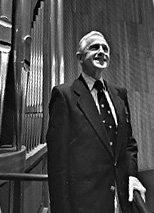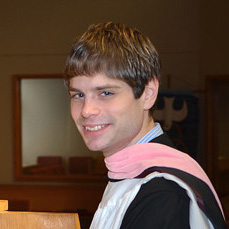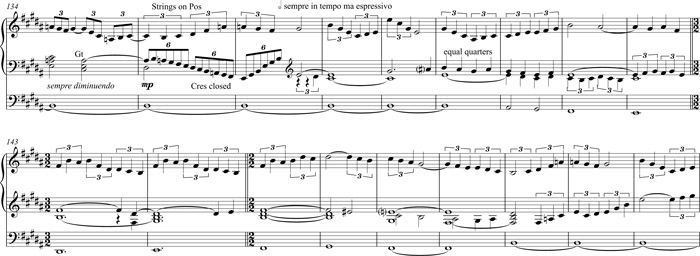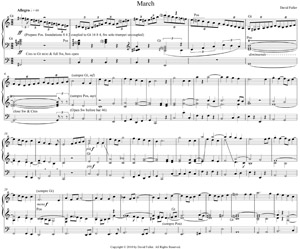 |
||
|
|
|
Celebrating the pipe organ, the King of Instruments |
A Marvelous March: The story of a nine-minute piece that took fifty years to write.

David Fuller
Musicologist and SUNY-Buffalo Professor Emeritus David Fuller began composition of a ‘commencement march’ more than half a century ago. Pipedreams host Michael Barone learned about it a few years ago during casual conversation as he and David walked between venues during an Organ Historical Society convention in Chicago. Though Fuller claimed not to be a composer, he’d been tinkering with his march over the course of half a century. More recently, a University of Washington graduate student, Christopher Howerter, learned of the score and determined to transcribe Fuller's manuscript into a user-friendly format (which you can download!) and include it in a graduate recital.
Previoius to that, Professor Fuller had recorded the piece himself (he is an excellent organist), and after audition of that recording Barone was sufficiently delighted that he wanted to include the piece on Pipedreams. Lacking anything better, Barone created a title for Fuller’s score, which he hopes David will consider, since it truly is a marvelous march!
Christopher’s performance, used in our broadcast, was recorded on the same organ used by David, one that Fuller commissioned for the University at Buffalo (1990 C.B. Fisk, Opus 95). We even have David's own performance to which you can listen online as well.
NOTES ON THE COMPOSITION OF THE PIECE ENTITLED "MARCH"

Christopher Howerter
"I am attaching some notes about the piece. As is stated in various ways, I only just did this analysis (a half-century after beginning it) and was quite bowled over by some of the things I did completely unconsciously. It was an eye-opener for me into the process of composition, having spent a lifetime trying to teach students how music was conceived. It turns out that a lot of it may not consciously have been conceived at all, just written down the way it had to go, and this must be true of lots of music of which one tries to guess the composer's creative thought-processes."
These are David Fuller’s extensive reflections on the genesis and content of his March.
The body and main parts of the piece with the principal themes and key-scheme were laid out as a commencement march probably in 1956-57. It was designed to be extendable to as much as 20 minutes or compressed as needed through the addition or subtraction of repeats. It was composed for organ, but the ultimate goal was to have it arranged for wind band for performance outdoors. It never received a proper title. As it was meant to be marchable-to, it moves with a steady half-note beat in 2/2 time throughout, including the quiet middle section in triplets of quarter-notes. Originally, the barring of this section was rigorously 2/2 even though here the music itself more often moved in phrases of three beats. (The conscious rhythmic model was Bach’s “Jesu, joy of man’s desiring.”) But the conflict turned out to defeat performers and the section had to be rebarred with changes back and forth between 2/2 and 3/2 (see bars 143-4 and three more comparable groups).
The form is that of a kind of rondo: A B A C A B A in the following key-scheme: C, G, C, B, D-flat, B-flat, C, all major. But over a half century of periodic revisiting, and as I gradually abandoned any thought of practical adaptability to the unpredictable timing of commencements, exact repeats and stopping places disappeared and a growing love of Wagner stimulated me to strive for seamless continuity –
something like his “unendliche Melodie”. The unusual key relationships–a half-step below and above C (which had been suggested to me long since by a symphony of C. P. E. Bach’s) and the more or less constant modulation invited delicious Wagnerian harmonies, and the several transitions were exploited for all they were worth. ( These also required smooth dynamic progressions, a considerable challenge for player and instrument.)
The rondo sections are mostly shaped by “bar-form”–a a b: two Stollen and an Abgesang. This is clearest in the first A and the C and freest in the Bs. The Abgesang of the first bar-form, running from measure 29 or 30 to 45 or 46 (depending on how you count measures that simultaneously end the preceding phrase and begin the following one) terminates with a little four-measure tune that I had thought up and written down in my middle childhood, judged beautiful, resolved to make a piece out of, and didn’t. Its use here was deliberate, though I do not recall the mental processes that went into its incorporation. What I do know is that once stated as the closing theme of the first A (bars 40–43), it continued to materialize again and again, sometimes complete, sometimes represented by only the first half (x) or second half (y), until in the eight bars before the end it dissolved into a frenzy of imitative fragments on the full organ. The syncopated rhythm of the cadential bar, though a common cliché, was in this case consciously inspired by Elgar’s Pomp and Circumstance no. 1 in D.
The six-bar introduction was added some 40 years after the piece was begun because I thought it needed an attention-getter. The idea of beginning out of the key came from Mendelssohn’s wedding march, but I thought I’d go one better than Mendelssohn’s ii6-5 of iii over the bass note F and start with a complete dominant ninth on F-sharp, as far from C-major as I could get. I then discovered, some time after I had drafted the six bars, that the triplet-motif that would later dominate the quiet middle section fitted beautifully into the modulation to C in bars 3 and 4. What I did not notice until just now is that those initial quarter-note triplets are made out of the ascending figuration of the second and third bars of the introduction taken at half speed. These interrelations happened spontaneously, as though the motifs had understood their destiny. I wrote them down automatically.
It was around this time that I solved my greatest problem with the piece: how to force it back into C-major at the end of the last A-section. I did not want to sacrifice what I thought (and still think) were some new, achingly lovely climactic progressions, but they always seemed to drag me toward G instead of C. The solution turned out to be simple: a chromatic scale running from e up to c over a bass descending to what was now clearly a dominant g (264-8). The 15 bars from here to the end now seemed to compose themselves in an enormous cadence (both authentic and plagal) with V2 of IV on the full organ (heard here for the first time) and crowned by the two childhood motifs x and y, each in imitation with itself.
I always suspected that I could not have invented the opening march-tune all by myself, but I never was able to discover whence I might have got it. It was only in December, 2012, a month or so before the present writing, that I realized that I had been hearing its elements all my life in the finale of Beethoven’s fifth symphony. The most striking of the transformations that his theme undergoes in the course of the piece is in bars 317-19 where a pair of bassoons, unaccompanied and blowing double forte, declaim a kind of condensation of the head of my theme. But Beethoven’s explosive energy overwhelms my much quieter development of similar materials and shows my vigorous introduction to have been a lucky and prescient inspiration.
The march tune is an innocent borrow, but two others are deliberate. The first B section is made of four similar subsections, three of eight bars and the fourth somewhat longer, of which four of the bars (79 to 82) are deliberately borrowed from a phrase in the “Libera me” from Fauré’s Requiem, whose harmony I had always loved. It is where the baritone soloist sings, ”Quando caeli movendi sunt et terra” (when heaven and earth are shaking) and contains two lovely half-diminished sevenths–my rendering has three.
The reprise of the A section that follows is transformed by the most audacious of the borrows, the motif of the illicit love of Siegmund and Sieglinde, twin brother and sister, from the third act of Die Walküre. It sings out out defiantly over the unimpeachably proper march tune for no reason other than that I liked it and it fitted. The second Stollen of the bar form retains original phraseology and the general melodic and rhythmic character, but it is essentially recomposed over a fast pedal obbligato whose purpose is simply to show that the organist really can play with his feet in this otherwise technically undemanding piece.
In the next transition, the longest, the the music melts dynamically, harmonically, rhythmically, melodically, registrationally, in every way as seamlessly as I could make it, into section C of the rondo, so that one is not aware of having arrived until it is well under way. It is essentially a quiet duet between strings and a French-style harmonic flute in which organists may be startled to hear the flute soar up from an accompanying role to the beginning measures of Bach’s “9/8” prelude in C, transposed to E, two octaves and a third above the original. I did not plan this quotation, but rather became aware of its possibility, and I am not yet entirely convinced that it is not intrusive, or perhaps just silly. In my recording of this piece, the balance in section D depends upon this harmonic flute, which is very different from typical, quiet, unobtrusive, Anglo-American examples. Its primary role is as a member of the chorus of foundations on the great manual, and as such it is scaled and voiced to be loud rather than soft. But this loudness is notably greater in the treble than in the tenor and bass, so that there is a crescendo as one goes up, almost as if it were enclosed and one were opening the box. Used as a solo stop, it supplies its own dynamic expression, and when playing in a duet with a more conventionally regulated stop, as here, it can completely reverse the balance between the two as it goes up in pitch, heard as accompaniment in the lower registers and as soloist in the treble.

Excerpt with some Bach references.
The D-flat-major fugato, which begins in bar 178, qualifies as the fourth A-section of the rondo since the subject is the first part of the march tune. The retransition from section C uses the same technique as the preceding transitions B to A and A to C: a crescendo to cover the introduction of a new registration, but here there is also an elaborate thematic transition showing that the march tune and the childhood tune are related–perhaps fundamentally the same. To explain this would take too many words, but the reader will be able to see it upon careful examination of the motivic content of bars 167 to 178 and following. I shall not try to argue that this relation may in some way reflect the incestuous connections linking Siegmund, Sieglinde, and their son Siegfried. No such thought ever occurred to me before this writing. But it is true that the technical resemblances between the two tunes (which I also never noticed before) are directly comparable to those shown by Wagner to link the ring–motif and that of Valhalla–the building of which was ultimately paid for by the ring–in the transition between the first two scenes of Das Rheingold. (The fact that my fugue subject and Valhalla are both in D–flat can only be a divine miracle, since I did not know Rheingold when I composed that fugato, and I barely knew what a Leitmotiv was. ) Note that the whole 12–bar Stollen of the march is played by the pedals in B-flat minor in bars 201–212–the only instance of a minor key in the March, and as unplanned as almost everything else.
The second appearance of the B–section (bars 213-39) was originally eight bars longer, and it was only at the very last minute–I think after the digitalization of the piece had been begun by Christopher Howerter–that I realized that I did not want to hear yet another repetition of that eight bar B-unit, already heard six times including the first B–even though all were different in various ways–and I cut them. There was no need for a transition to this B–section, because the section itself incorporates the final modulation back to C-major and the final A.
In addition to the original organ version, Professor Fuller explored the option of making the piece playable by a concert band. Here are his comments:
It was not until 1992, after having made the acquaintance of a clarinetist in the Air Force Band at Langley Field in Norfolk, Virginia, that I decided to test whether the piece would work for the medium that had been intended from the beginning. At my expense it was arranged by the band's regular arranger, Lawrence Odom of Poteau, Oklahoma, and in early 1995 a read-through was organized under the direction of the conductor, Lt. Col. Lowell Graham, to which I was invited.
The arranger thought that my introduction, which began fortissimo on a complete dominant ninth chord in the key of B-major, modulating through rapid passage-work to the main key of C-major, ought to be preceded by an opening fanfare in familiar military-band style, and he composed two or three to choose from. I should say that at no time in the composition of this piece did I pay any attention to what was comfortable or even possible to play on band instruments. I did not appreciate how lucky I was to have had superb professionals to arrange and sight-read it.
What I really learned from this enterprise was that what I had composed was organ music, not band music.
Cheers, David


